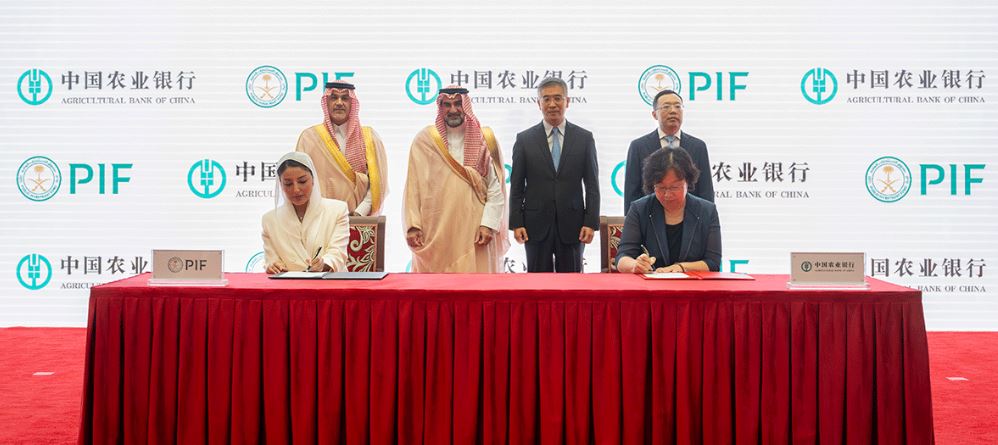- PIF of Saudi Arabia Signs MoU of $50 Billion with Six Chinese Banks
- The leading financial institutions include’ Agricultural Bank of China, Bank of China, China Construction Bank, China Export & Credit Insurance Corp., Export-Import Bank of China and the Industrial and Commercial Bank of China
- Saudi Arabia, China Cooperation Boom under the Belt and Road Initiative (BRI)
- Robust expansion seen in China and the Arab League Cooperation
By: Muhammad Arif, Editor NSN.Asia
Riyadh: The Public Investment Fund, sovereign wealth fund of Saudi Arabia, has signed memoranda of understanding worth up to $50 billion with six Chinese financial banks under broader vision of Saudi kingdom to deepen its business and economic cooperation with Beijing.
The Public Investment Fund or PIF is a global and domestic investor. As one of the world’s largest sovereign wealth funds, PIF is a key driver of Saudi Vision 2030.
PIF signed the agreements leading financial institutions that include Agricultural Bank of China, Bank of China, China Construction Bank, China Export & Credit Insurance Corp., Export-Import Bank of China and the Industrial and Commercial Bank of China, a statement from Saudi fund said Thursday.
Furthermore, PIF statement said the documents cover areas of cooperation such as encouraging two-way capital flows through debt and equity.
Fahad AlSaif. PIF’s Head of the Global Capital Finance Division and Head of Investment Strategy and Economic Insights Division, said: “The MoUs demonstrate PIF’s strong and deepening relationships with leading financial institutions and accentuate PIF’s commitment to enhancing partnerships globally.”
The core purpose of PIF is to support Saudi Arabian Crown Prince Mohammed bin Salman’s ambitious Vision 2030 plan to diversify the kingdom’s economy away from a reliance on oil by investing in other sectors such as clean energy, entertainment, sports and tourism.
- Saudi Arab and China expand bilateral cooperation in energy sector
Under this vision, both Saudi Arab and China have fostered their bilateral cooperation in energy sector. China is Saudi Arabia’s biggest customer of crude oil and the two countries have heavily partnered in building factories and projects for other commodities, such as solar energy and petrochemicals.
Recently, on July 21, Saudi Aramco announced that it acquired a $3.4 billion stake in China’s Rongsheng Petrochemical Co. Ltd.
Also, China holds prominent position as the first destination for Saudi exports, with a ratio of 15 percent of total exports, according to the international trade report for the first quarter of 2024 issued recently by the General Authority for Statistics (GASTAT). The report reflects the volume of economic and trade cooperation between the two countries.
The most notable achievement of this bilateral cooperation is represented by the volume of Saudi non-oil exports to China. The value of Saudi non-oil exports to China during the past five years from 2019 to 2023 exceeded SR176 billion. Chemicals, polymers and metals topped in the list of Saudi non-oil exports to China.
Transport and logistics sector represents one of the major components of the services exports sector, and one of the promising sectors contributing to increasing non-oil exports, along with the goods and re-exports sectors. The export of services to China recorded their best performance in 2023, compared to previous years, with an increase of 40 percent over the previous year, with a value of SR182 billion, according to the preliminary data released by GASTAT.
The rise in services export was supported by the recovery of the travel sector, which recorded a surge of 43 percent. The travel sector constitutes 74 percent of the total services, with a value of SR135 billion, followed by the transport sector, whose exports amounted to SR24.2 billion, and then exports of communications services, with a value of SR6.3 billion.
It is noteworthy that the efforts to boost Saudi exports to China are a continuation of Saudi Arabia’s efforts to further strengthen relations with China.
The meeting of Custodian of the Two Holy Mosques King Salman with Chinese President Xi Jinping in 2016 in Riyadh was a landmark initiative in this regard. During the visit several agreements and memorandums of understanding were signed between the two governments. These included a memorandum to enhance joint cooperation regarding the Belt and Road Initiative (BRI), and the 21st Century Maritime Silk Road, which is a key component of BRI.
The Saudi-Chinese relations were strengthened significantly in 2019, following the visit of Crown Prince and Prime Minister Mohammed bin Salman to China, during which the summit level meetings reviewed the joint coordination efforts made to enhance cooperation between Saudi Arabia and China, which reflects the depth of relations and strategic partnership between the two friendly countries in various fields.
Additionally, trade between China and the Arab League has also witnessed robust expansion as the two partners bolstered economic cooperation since the China-Arab States Cooperation Forum was established 20 years ago.
according to China’s General Administration of Customs (GAC), total goods trade volume between China and members of the Arab League surged to 2.8 trillion yuan (about 393.75 billion U.S. dollars) in 2023 from 303.81 billion yuan in 2004, an increase of 820.9 percent.



